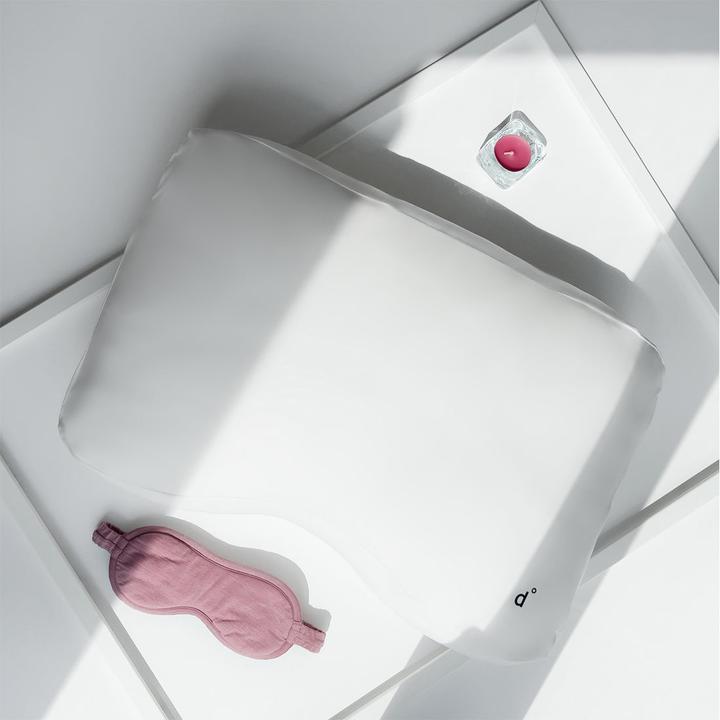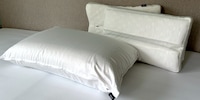

Functional and comfortable: the Dagsmejan pillow gives a winning performance
Soft and fluffy or ergonomic? It’s up to you which pillow you go for. But you can’t have both. Wrong. I should say you couldn’t have both. In my opinion, there’s a perfect balance of comfort and support with the Functional Pillow from Dagsmejan.
The name Functional Pillow doesn’t necessarily sound comfortable. That’s why I was sceptical at first when Dagsmejan sent me one to test. But the pyjamas from the Swiss company have done me wonders for a few years now, so I thought I’d give the pillow a chance. A good decision to do so, as I soon find out.

The pillow isn’t named after a city or a mountain, nor is it named with a complicated number-letter combination. It’s simply the Functional Pillow from Dagsmejan. I even allow myself to just call it a «pillow».
The size of the pillow isn’t particularly big, measuring at 50 × 33 centimetres. Eleven centimetres in height, on the other hand, is something, even for people with broader shoulders or harder mattresses. You can read about how these two factors affect your pillow choice here:
However, the measured height alone says little. A feather-filled pillow can be very high, but after a short time goes flat. I hardly sink in when I sleep on the Dagsmejan pillow. Yet the pillow is soft. It’s made of two parts:
- an insert with kapok filling (more on that in a moment)
- a padded cover made of 90 per cent lyocell and 10 per cent kapok
Also available separately is a cover with eight per cent elastane that exactly matches the U-shape of the pillow. The fabric for this is the same that Dagsmejan uses for their pyjamas. The material turns out to be really comfortable in the test run because it feels cool on the skin.
The natural fibre kapok and its hidden secret
Most manufacturers use either feathers or chemically produced fibres as a filling material for pillows. Synthetic foams are also used, particularly for functional pillows. With the feather-based pillows, stability and ergonomics leave a lot to be desired. Ergonomic pillows try to bring the neck into the optimal lying position with their chemically produced foams – think memory foam, in particular? The price for this is that the pillows often feel hard. Plus I sweat faster and sweat more on them because foam often isn’t as breathable despite all the pores and layers.
Dagsmejan has found a third way, one which combines both ergonomics and comfort. Among other things, one crucial decision was made for the filling material – kapok fibres (aka silk cotton). These are the fruits of the kapok tree. The fibres growing in the fruit capsules look similar to cotton fibres. Kapok trees grow in Indonesia, Malaysia and Java. The fibres that Dagsmejan uses come from there. The trees also grow in the Caribbean and can’t be grown on plantations. The pods, and their fruit capsules which the fibre oozes from, are collected in the wild which means they are free of fertilisers and other pollutants.

Source: Martin Jungfer
The kapok fibres that Dagsmejan uses are processed into a pillow filling material in Slovenia. About 450 grammes of the purest fibres are in each pillow. I can also make the pillow lighter and flatter. To do this, I open the zip on the inner lining and the brown kapok fibres are right there. If I take a handful or multiple handfuls of the filling out, the pillow will be flatter. The fibres feel soft and fluffy. Kapok is sometimes referred to as plant cashmere, and rightly so!
Plus kapok fibres have other good properties:
- Kapok fibres are hollow. Therefore, they dissipate heat and moisture well and regulate temperature.
- Due to a kind of wax layer on the fibres, kapok doesn’t absorb moisture. This is particularly advantageous for people who sweat heavily from their head while sleeping. The filling from the natural fibre keeps you dry when lying down.
- The waxy surface also ensures that microorganisms such as fungi, viruses and bacteria don’t find a breeding ground.
When it comes to care, kapok fibres are frugal. They don’t need to go in the washing machine. It’s enough to dry the insert (with the fibres in) in the sun, from time to time. You can put the cover of the Dagsmejan pillow in the washing machine on a gentle wash. Like all natural fibres, kapok doesn’t live forever. After two years at the latest, they lose their wax layer and with it their good properties. Then it’s time for a new pillow. Or a new filling with fresh fibres.

Source: Martin Jungfer
The ergonomic U-shape
If you search for ergonomic pillows on the internet, you’ll find examples more reminiscent of medieval torture devices than aids for comfortable sleep – in our shop, too. Those keep my head in the hollow part of the pillow which keeps my spine straight. But they often don’t look comfortable.
Especially since I like to believe the research and studies that say that we humans turn to a new position up to 40 times during sleep. Even though most people sleep sideways, we do lie on our backs some of the time. Some even on their bellies.
That’s why I’ve never been a fan of functional pillows designed specifically for side sleepers or specifically for back sleepers. Dagsmejan has chosen a U-shape for its pillow, though it only marginally deviates from a basic rectangular shape. At three or four centimetres, he indentation is quite discreet.
Still, there’s a noticeable difference when I lie on it compared to regular rectangular pillows. If I lie on my side to fall asleep, my shoulder fits perfectly into the indentation. At the same time, my head isn’t on the edge of the pillow. I’m not concerned that I’m going to slide around like with the other models. As a result, I’m more relaxed when lying down and I don’t have to use my hands under the pillow to avoid slipping.
Although the Dagsmejan pillow is smaller than most other pillows I’ve tested, the comfort is significantly greater. Even though I can’t watch myself while I sleep, of course, I feel it makes switching sleeping positions less tiring. The shape makes a huge difference. I feel like I’m in good hands with the U-shape.
The price tag on good sleep
If the pillow cost 50 or 70 francs, the test report would end here. My conclusion would be one word: buy! But we still need to talk about the price. The Dagsmejan pillow costs just under 160 francs. For the special pillowcase, it’s another 70 euros on top. That’s not cheap. I still recommend the pillow. With certain purchases, quality and well-being are more important to me than being able to save a few francs. Pillows being one of them. I lie on it every single day, there are few things that are so close to me otherwise. Even the natural fibres in the insert are a plus. If you want, you can calculate the price of the pillow based on how many cents it’ll cost you per day. Then you’ll definitely be able to sleep at night.
Here are a few more impressions of the pillow.
For English subtitles, click the gear icon, «Subtitles/CC» and «Auto-translate».
Header image: Manuel Wenk / Martin Jungfer
Journalist since 1997. Stopovers in Franconia (or the Franken region), Lake Constance, Obwalden, Nidwalden and Zurich. Father since 2014. Expert in editorial organisation and motivation. Focus on sustainability, home office tools, beautiful things for the home, creative toys and sports equipment.




